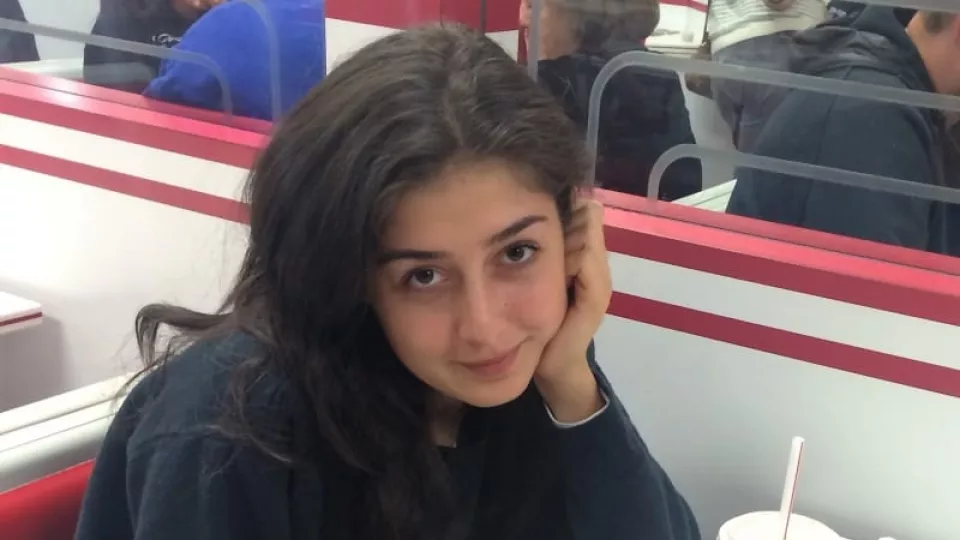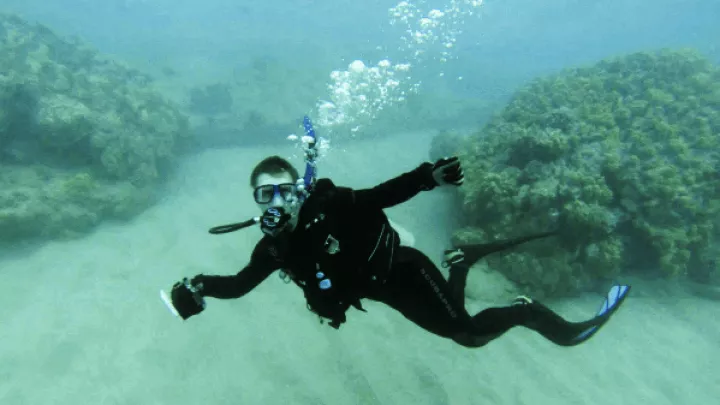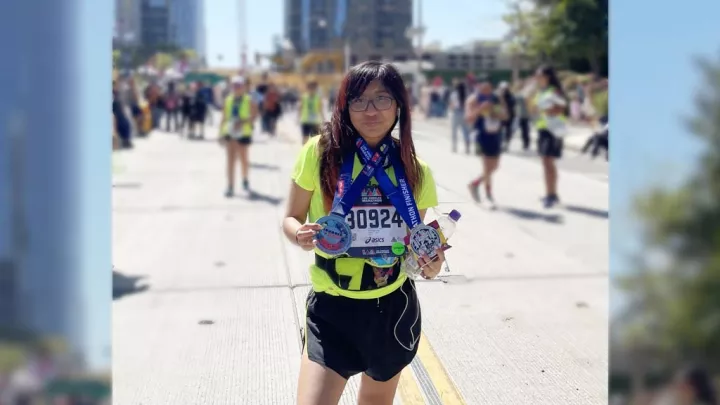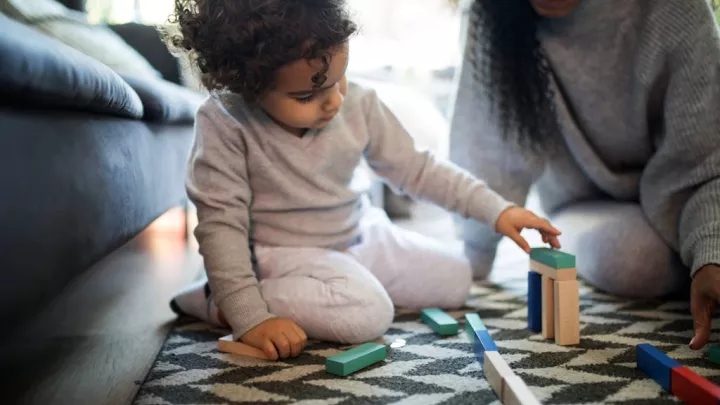
‘I Can Do Anything I Want’
Surgery for hip dysplasia leaves Leana Vardanian pain-free and ready for a bright future.
For Leana Vardanian, the first moment she knew something was terribly wrong came in sixth grade, when she stood up from her desk at school and immediately fell to the floor. Her left leg had simply folded under her.
Shocked and confused, the 11-year-old sat there for several minutes before being able to get up. The episodes began recurring. Leana played on the school tennis team—“I loved it,” she says—but as the pain in her hip returned and her leg weakened, she had to quit the team.
The family lived in Gresham, Oregon, just east of Portland, and Leana’s mother took her to see a series of doctors. Each, in turn, diagnosed the young adolescent with “growing pains.”

Eventually, the family moved to Glendale, California. Leana remembers a day she was home alone and fell again while her mother was at work. Her leg and foot “felt like a flat tire,” says Leana. By the time she reached her cell phone via a series of painstaking, side-to-side maneuvers to call for help, the phone’s battery was dead.
Leana rejoined the tennis team in her freshman year of high school, but had to drop out again. When she told another doctor she had noticed that one of her legs seemed shorter than the other, he told her she was mistaken. The Vardanians moved again, this time to Sherman Oaks, where a concerned family practice physician finally referred Leana to Children’s Hospital Los Angeles.
The right diagnosis
At CHLA’s Orthopedic Center, Leana met orthopedic surgeon Rachel Goldstein, MD, MPH, of the Center’s Hip Preservation Program, and immediately “felt so safe.” Goldstein ordered an MRI of Leana’s hip, and the teenager waited anxiously. The moment Goldstein walked back into the room with the results changed Leana’s life. “I finally knew what was wrong with me,” she says.
The diagnosis: significant hip dysplasia, or developmental dysplasia of the hip (DDH). Not only was Leana’s hip joint out of alignment, the condition had caused one of her legs to become 8 percent shorter than the other, verifying the teenager’s own diagnosis.
The hip is the largest “ball-and-socket” joint in the body. The ball, or femoral head, sits on top of the femur, or thighbone. The socket, or acetabulum, is part of the pelvis. The ball must fit properly into the socket to enable the joint to rotate freely. Aiding this process is cartilage, which covers the ball and socket, as well as the socket edge, ideally allowing the whole mechanism to glide in motion.
Developmental dysplasia includes a spectrum of abnormalities, ranging from a too-shallow socket to a completely dislocated hip. Sometimes, as in Leana’s case, the hip socket isn’t in the correct position to completely cover and support the femoral head.
This causes increased force and abnormal wear on the cartilage and surrounding tissue, which causes pain. Left untreated, the hip joint can become irreversibly damaged. The condition can occur in patients only a few days old or remain silent until adolescence or even adulthood.
“Fortunately, we understand more about the hip than any other joint in the body,” says Goldstein. “This enables us to utilize advanced surgical techniques aimed at hip preservation, which is critical in treating children and young adults.”
Meet the pediatric specialists
Two years ago, the Orthopedic Center—annually ranked among the top 10 pediatric programs nationwide by U.S. News & World Report—debuted its Hip Preservation Program, a complement to its longstanding Hip Disorders Program. Its chief goal is to prevent the need for hip replacements for people in their 20s and 30s. “If we can perform a surgical revision on a teenager or young adult, and do whatever we can to preserve the hip,” says Goldstein, “we can help that person avoid a lifetime of hip replacements.”
The typical hip replacement lasts about 15 to 20 years. Newer hip replacements are purported to last 20 to 30 years, but the evidence isn’t yet in to back up that estimate.
The experts in the Hip Preservation Program, which is unique in Southern California, specialize in diagnosing and treating congenital and developmental hip disorders, post-traumatic hip abnormalities, sports-related hip injuries, and adolescent and young-adult hip pain. ”As pediatric orthopedists at CHLA, we have special training for musculoskeletal disorders seen in children, and fully appreciate those challenges,” notes Goldstein.
Treatment for hip dysplasia varies based on the patient’s age and the severity of the problem. Infants and young children can often be treated with bracing or casting, while older children, adolescents and young adults may require surgery.
Looking ahead
The MRI that revealed Leana’s faulty hip joint enabled Goldstein to chart a course to repair it, basically realigning the socket and placing the ball and socket back into position—a procedure that took about five hours.
Leana admits to being somewhat nervous on the day of surgery in November 2014, but thrilled at the prospect of ending five years of pain. “I couldn’t have asked for a better surgical team,” she says.
Leana remained at CHLA for five days, where she was impressed with the dedication of her doctors, nurses and therapists. She then spent about six weeks on crutches and several months in physical therapy.
She’s gone back to playing tennis as well. “I don’t have pain when I run anymore, which is great, but I also don’t have the same flexibility to position myself on the court yet.” She loves to hike. “With the pain gone, I can go hiking for hours,” she says.

The experience of seeing her condition visualized in MRI images led Leana to volunteer in a radiology department at a hospital near her home after she recovered. “I wanted to find out if I’d enjoy it,” she says. She did.
Now a senior at Grant High School in Valley Glen, and turning 18 in November, she’s plotting a future in medicine, either as a pediatric nurse or an MRI technician or both. “I was interested in medicine before this, and now I’m more determined,” she says. “I love the hospital environment and I love kids.”
More about dysplasia
Hip dysplasia is four to five times more common in girls than boys, though medical science can’t fully explain why. One possibility is that girls may be more sensitive to hormones their mother’s body makes to allow her ligaments to become lax and enable the baby to pass through the birth canal.
Two prevailing theories about adolescent hip dysplasia disagree about when it develops, says Rachel Goldstein, MD, MPH. One theory is that the dysplasia or misalignment is present from birth, but just hasn’t been diagnosed properly. The second contends the dysplasia is the result of a failure of development during puberty. “Right now we just don’t know and there’s no way to determine which theory applies in each individual,” says Goldstein.
The Orthopedic Center’s Hip Preservation Program at CHLA is looking for answers, heading up a research project examining the risk factors for delayed diagnosis of developmental dysplasia.
Other research efforts include a multicenter investigation with Vanderbilt University into slipped capital femoral epiphysis (SCFE), in which the top of the thighbone slips from position; this typically affects still-growing teens and preteens. A second multicenter investigation involves participation in the International Perthes Study Group, which is investigating a childhood hip disorder caused by a disruption of blood flow to the ball of the hip joint.
For some children and teens, CHLA’s John C. Wilson Jr. Motion and Sports Analysis Laboratory helps surgeons map out a surgical plan ahead of time. Motion analysis experts attached a series of sensors to the affected areas and a computer “reads” the points of strength and weakness.


